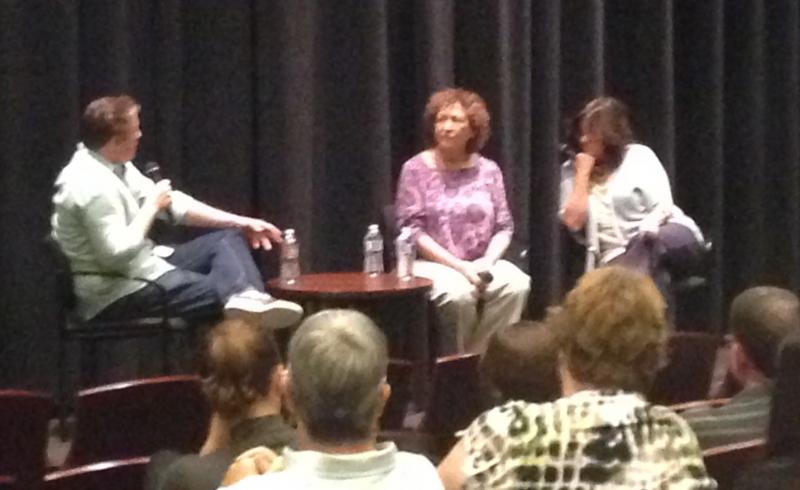She's Beautiful When She's Fighting For Her Rights

In an aptly-coined phrase, lifelong activist and second-generation suffragette Virginia Whitehill pinpointed the modern repercussions of the 1960s women's movement.
Whitehill is one of many feminist activists featured in Mary Dore's 2014 documentary, "She's Beautiful When She's Angry." The documentary, which is the first of its kind, was screened Sunday night at the Ray Stark Family Theater in USC's School of Cinematic Arts. Until now, there had never been a feature film or documentary depicting the birth of the Women's Liberation Movement.
"The women's movement has never gotten the respect it deserved," said Dore, who has been tirelessly researching, interviewing, and seeking funding for the film for slightly over two decades. The documentary presents a powerful and provocative account of the masses of women who fought for equal rights and the social and economic advancement of their gender.
The film, in large part, illuminates the integral aspects of modern women's lives that are too often taken for granted. It seems unimaginable that just 40 years ago, female job opportunities were capped at "secretary," women's studies were not offered as university courses, and women were unable to retrieve birth control without a marriage license. Even the seemingly inconsequential overlaps between traditional gender roles were frighteningly absent before the women's movement. "Men did not change a diaper in my era," Dore said, her eyes wild, "That was a revolution." Dore pointedly recalled that at the onset of the movement, women mostly existed for the purpose of co-existing with a man. "It was still very much about catering to men, and you know, catching a man," she said.
The story focuses almost exclusively on the early portion of the Women's Liberation movement, highlighting brilliant women of a wide range of ages, races, and social backgrounds who founded the backbone of the movement. Because she felt this was an aspect of history that had not been fully recognized, Dore selected intimate, intriguing video footage that captured the movement's origins. This included vintage clips of "The Feminine Mystique" author Betty Friedan, Ms. Magazine founder Gloria Steinem, and early rallies of the National Organization for Women (NOW).
As the women's movement gains momentum, so does the film. Dore expertly explores the multifaceted, complex interactions between the women who were involved in the movement. The admirably honest interviewees delved into the sensitive issues of race, class, sexual orientation, and leadership amongst activists. The film examines the initially confusing intersections between black women, queer women, and the women's movement as a whole.
"The women's movement was very combative," admitted Dore. But her filmmaking does the internal tension its due justice; one of the film's greatest strengths is its portrayal of women from all corners of the movement. Dore showcases women who were concurrently involved in the Civil Rights movement, women who participated in radical factions of women's rights, and the queer women who represented their voices through an inspiring demonstration in which they deemed themselves "The Lavender Menace."
The documentary thrives on its authenticity. It exposes with grace the innumerable power rooted in independent thought and inquiry. The story does an excellent job of conveying the simplicity of intelligent women who possessed the bravery to step back from their dissatisfying life experiences and ask, "Why?" It instills a very potent sense of empowerment and appreciation in its audience, as the women on screen breathe collective life into their ideas and eventually form a full blown revolution. The filmmaker's objective was to illuminate the incredible effects of grassroots, collective organizing, and she succeeded. "I did not want to make a film about individual heroics," said Dore. "I wanted to make a film about a movement."

These women were unrelenting activists, undaunted by predisposed concepts of taboo or social correctness. The film reveals the unbelievable extent of their boldness; activists managed to hang banners from the Statue of Liberty, protest from within Supreme Court hearings, and perform back-room abortions under the pseudonym "Jane." They risked both public and personal backlash, yet persevered with the knowledge that such actions were necessary in order to stimulate change. The women were certainly a force to be reckoned with. "Change happens because people organize," stated Vivian Rothstein, one of the founders of the Chicago Women's LIberation Union of the 1970's.
That being said, the timing of this film's release is impeccable. With nation-wide debates over birth control, sexuality, and sexual assault currently in the spotlight, "She's Beautiful When She's Angry" does an excellent job illustrating both how far our society has come as well as how far we've backtracked in terms of women's issues.
But Dore does not want the film to leave viewers feeling dejected. In fact, she hopes to instill the opposite sense of hope in her audience. "I want people to be empowered by the film. Because the whole point of showing the grassroots of it was that these are ordinary women," said Dore. After witnessing the extraordinary effects of the women's movement herself, she hopes that people who see the film will be inspired to keep pushing forward.
"You just do whatever you can do, and you can make a difference," she said. "Even if it's a small difference. Small differences can sometimes make very big differences." Mary Dore and the women featured in "She's Beautiful When She's Angry" are remarkable examples of such advice put into action.
"She's Beautiful When She's Angry" will premiere at the Nuart Theater in Los Angeles on December 12, and will play for one week only.
This story is part of Culture For Change, a month-long Arts and Culture exploration of cultural activism in L.A. For the other stories in the collection, click here.
Reach Senior Culture Editor Emily Mae Czachor here.



